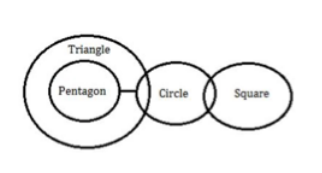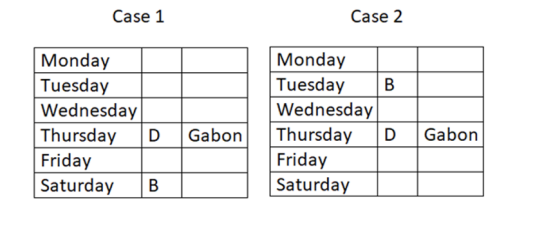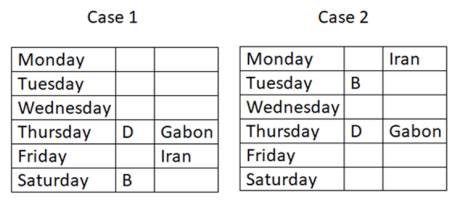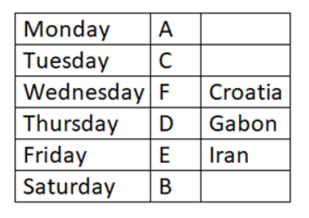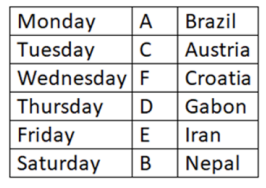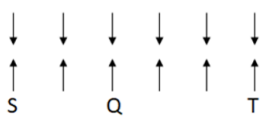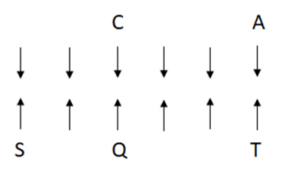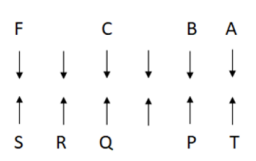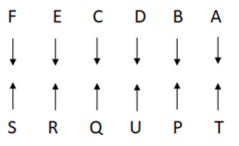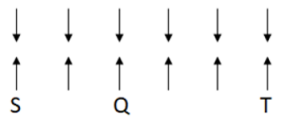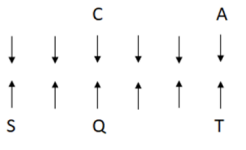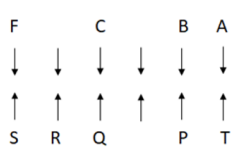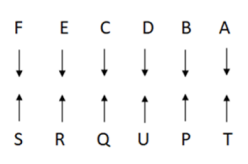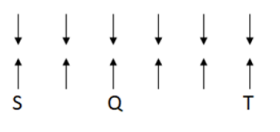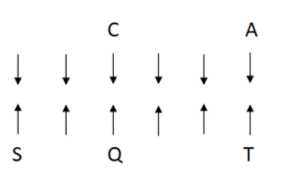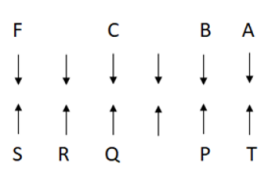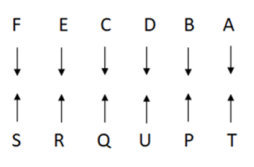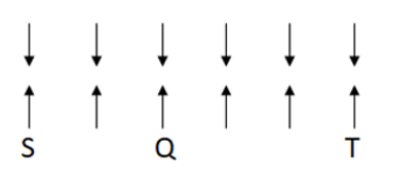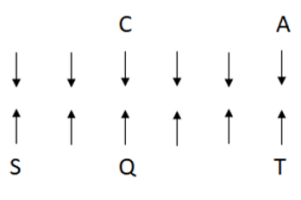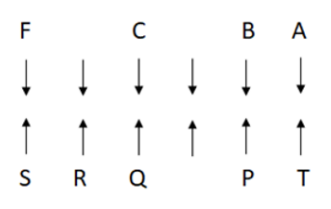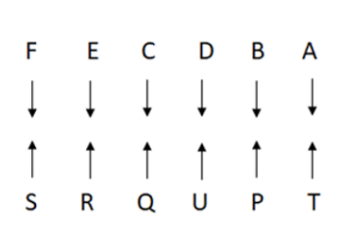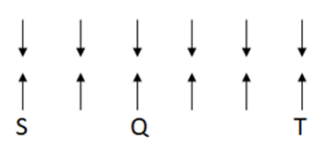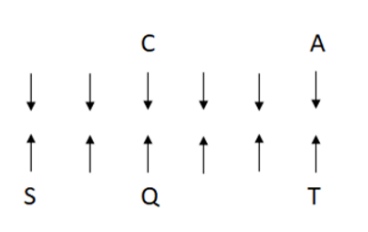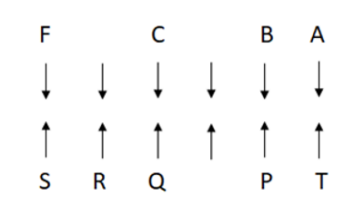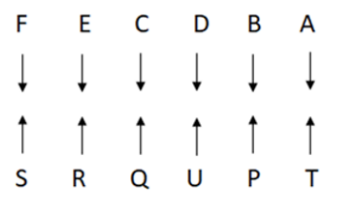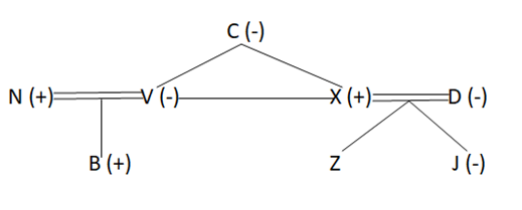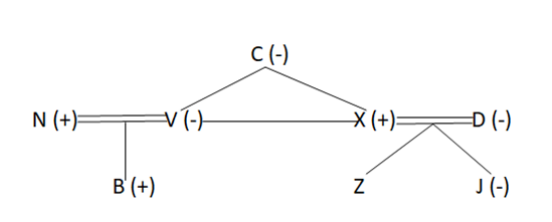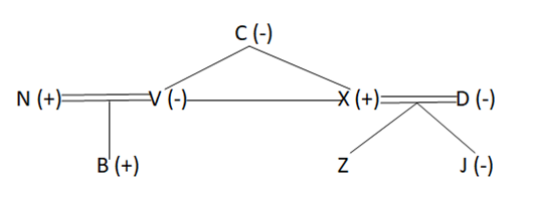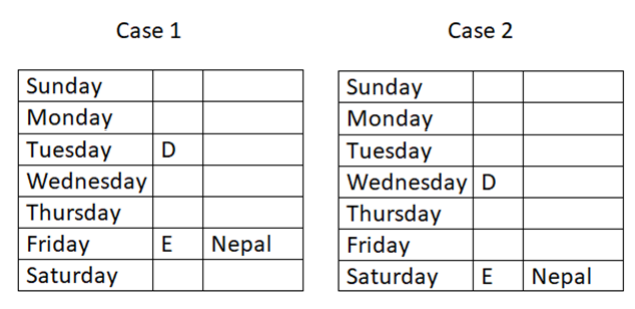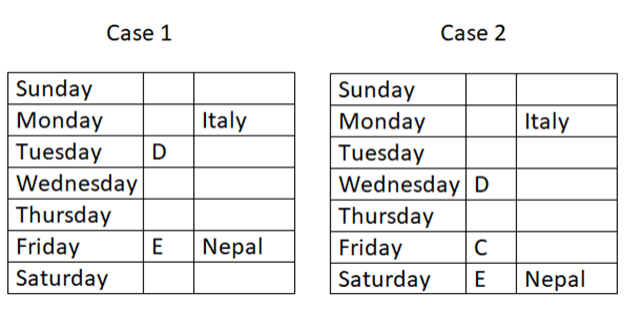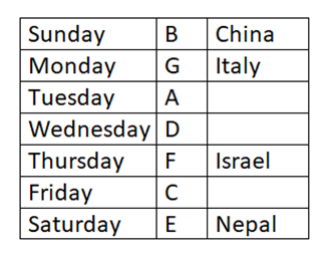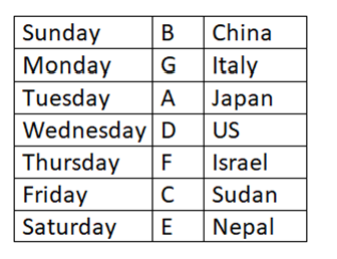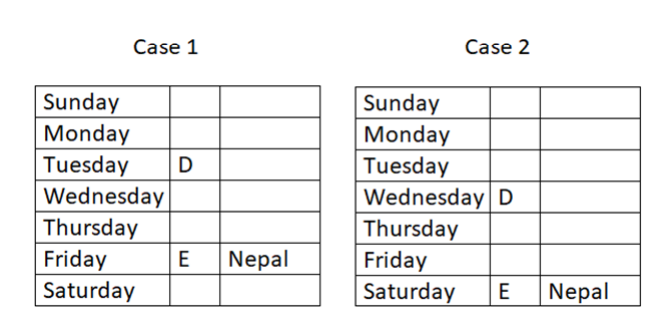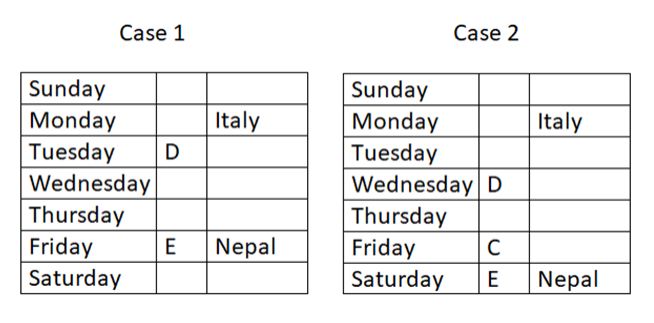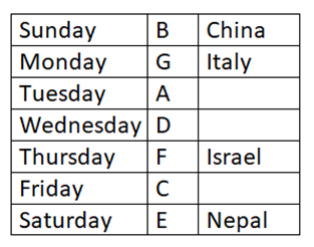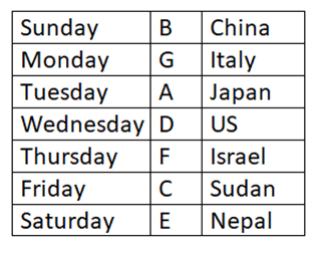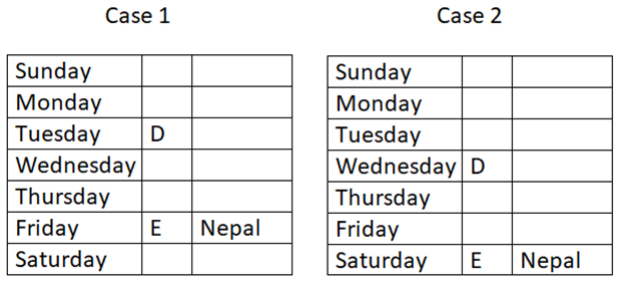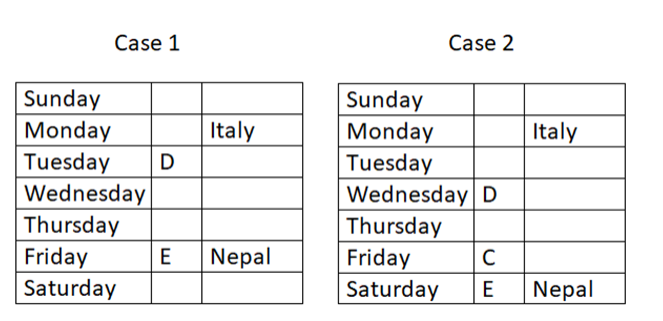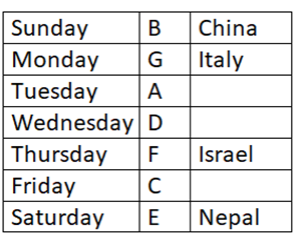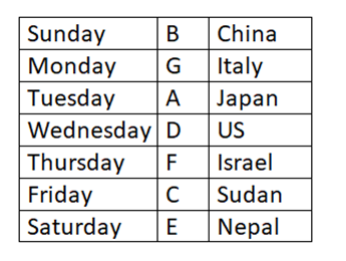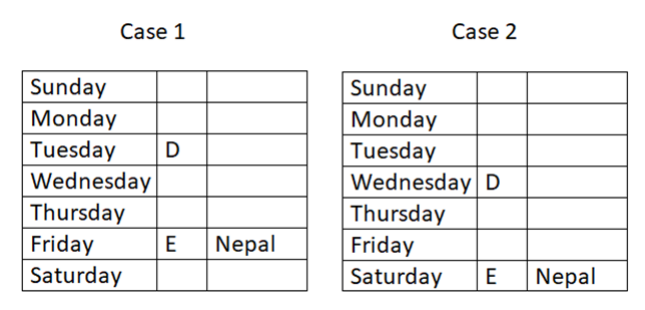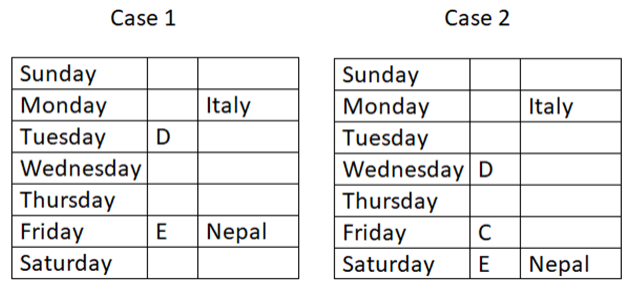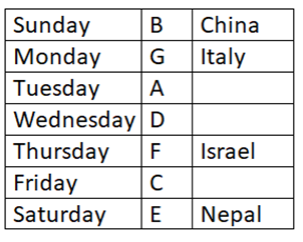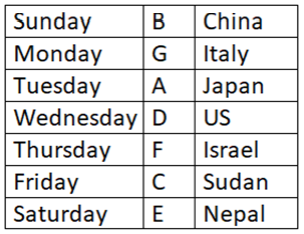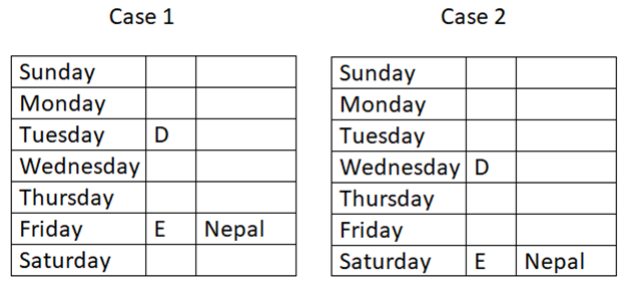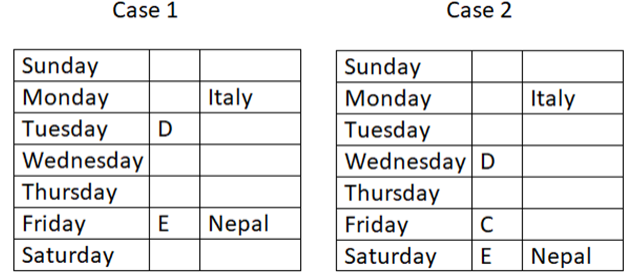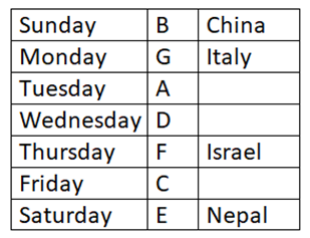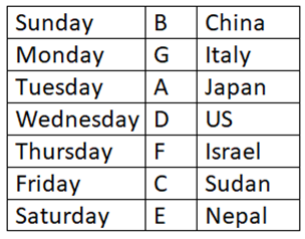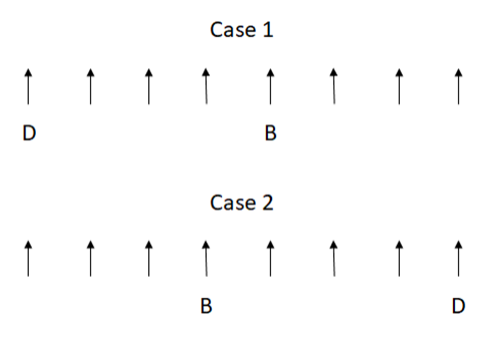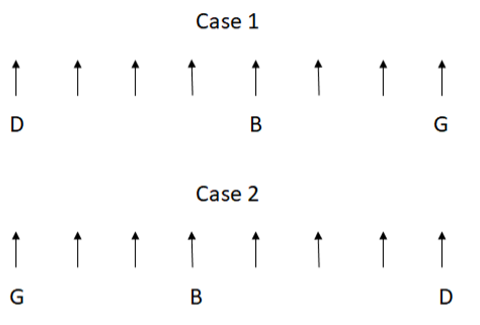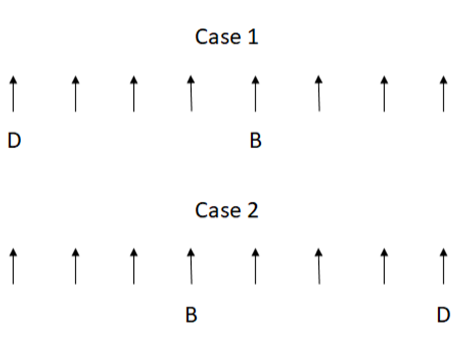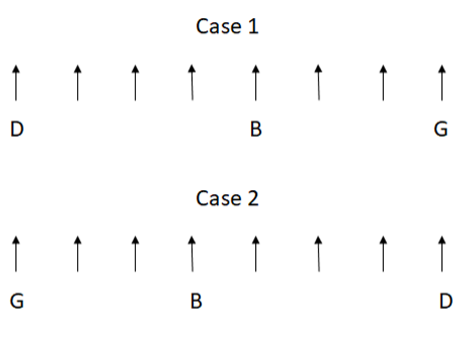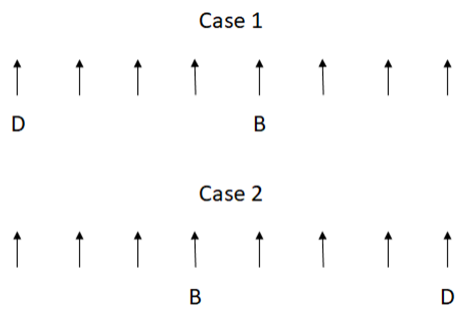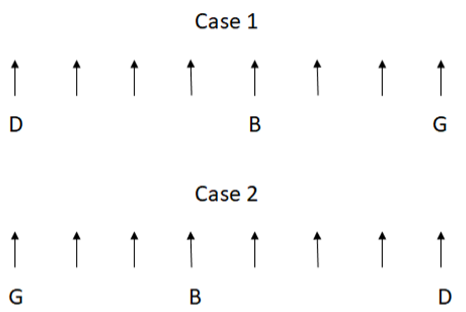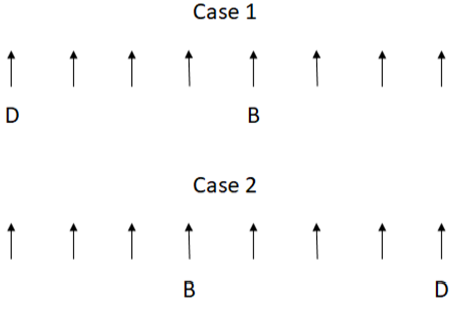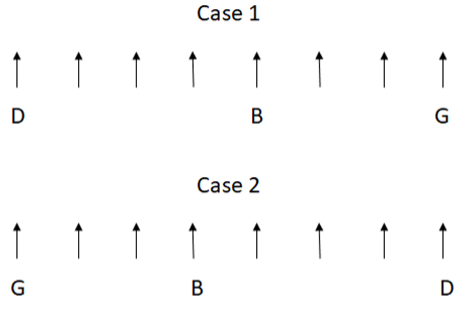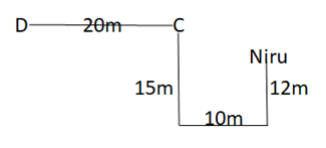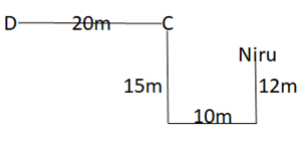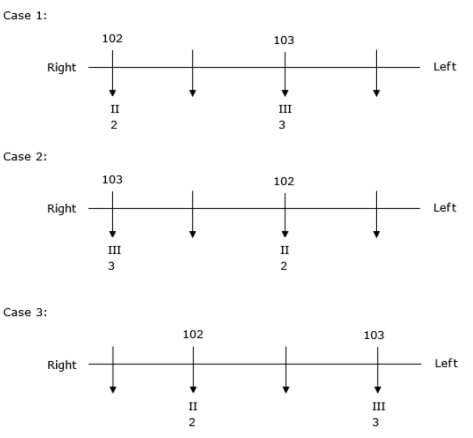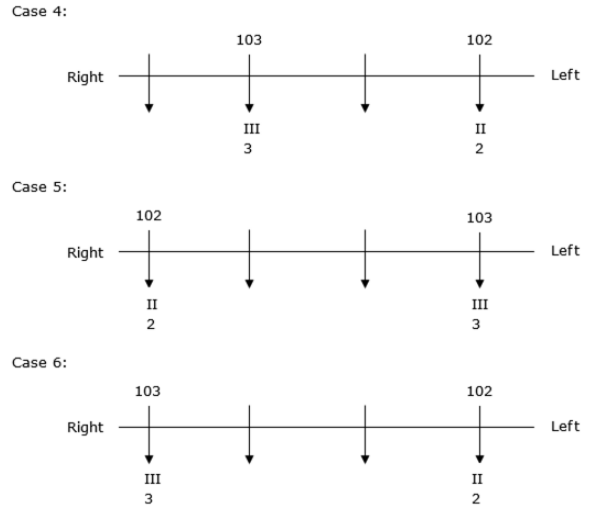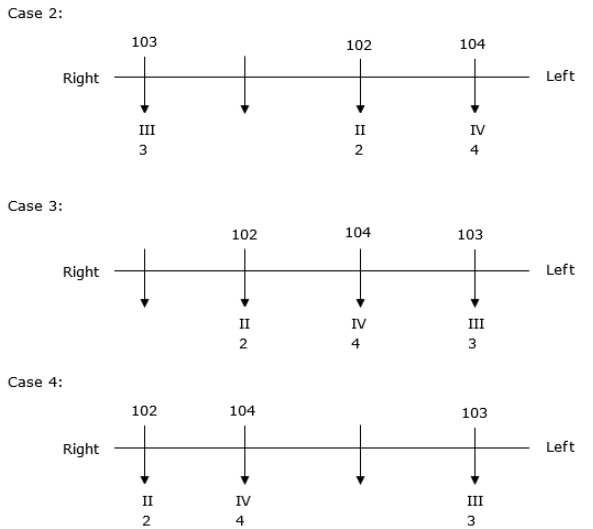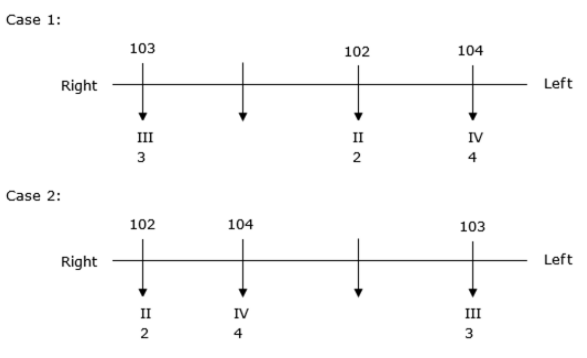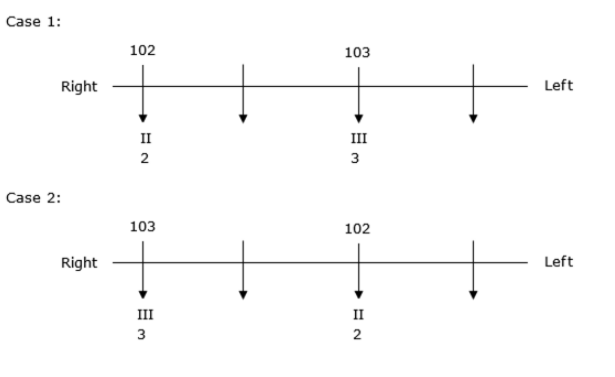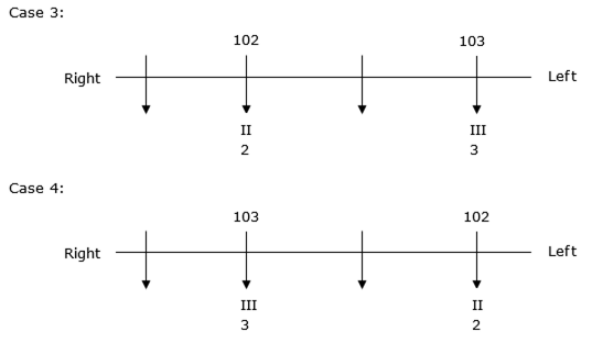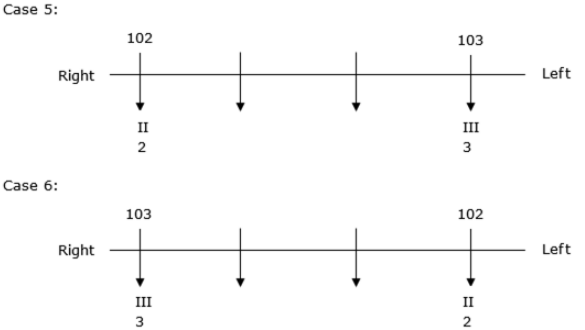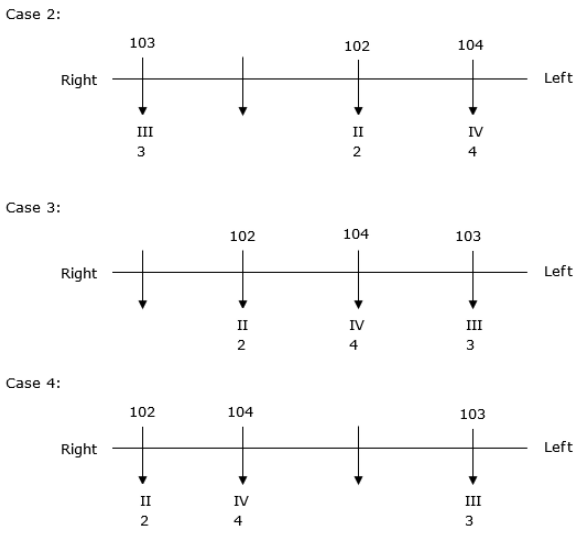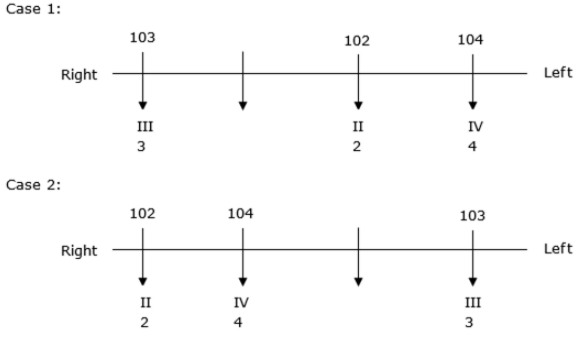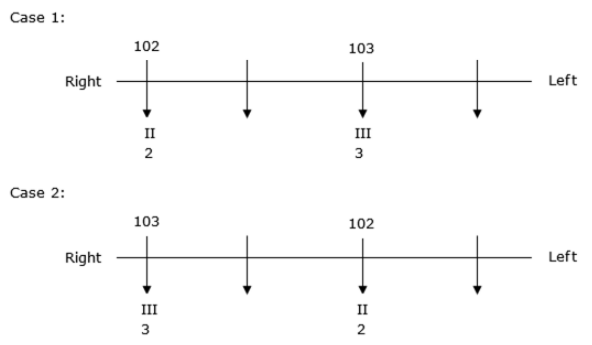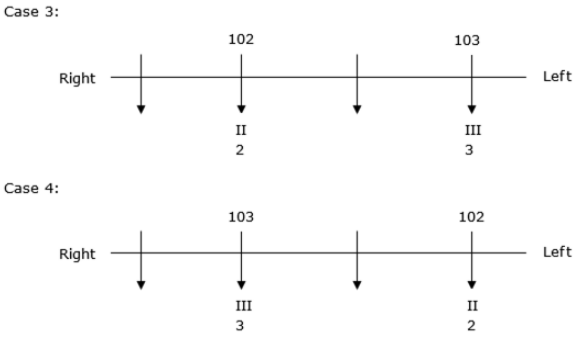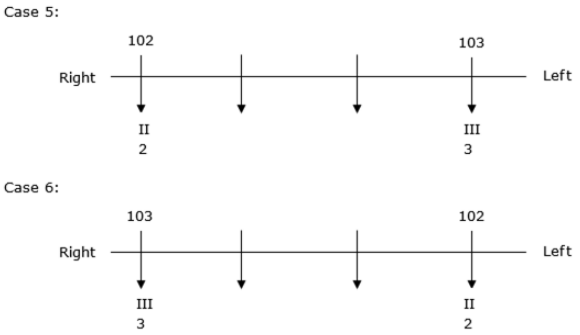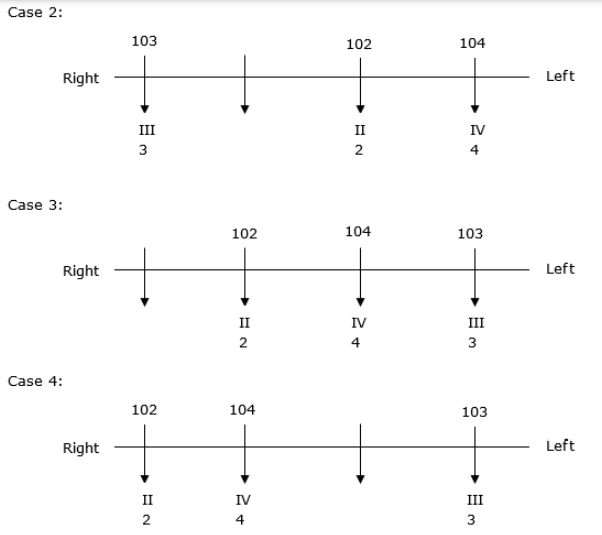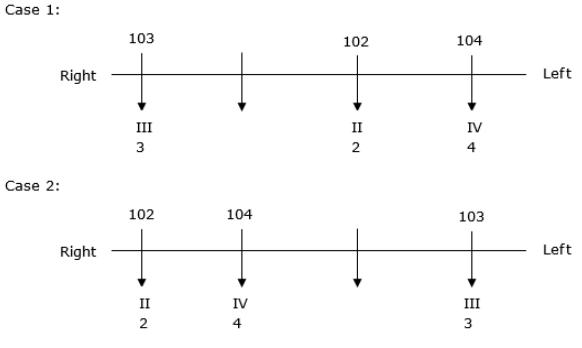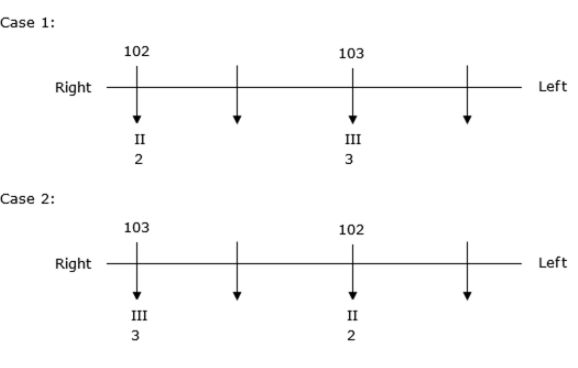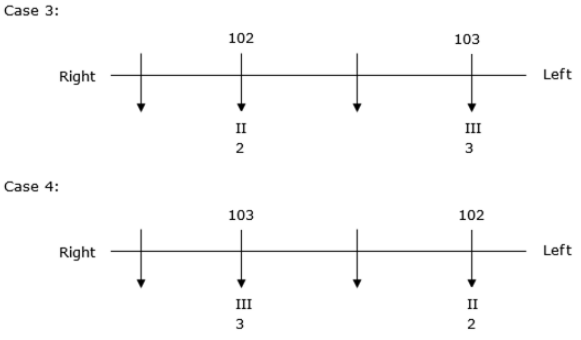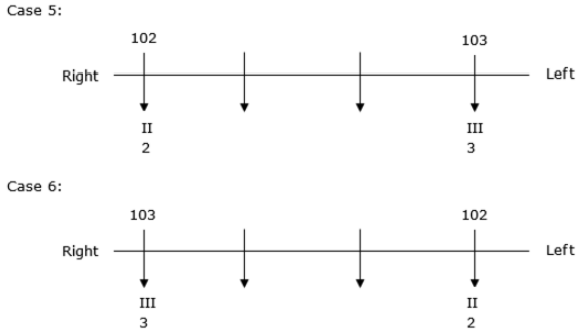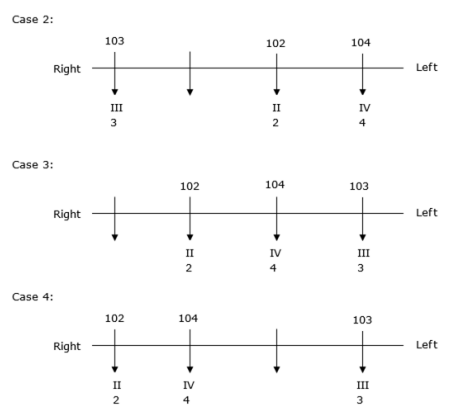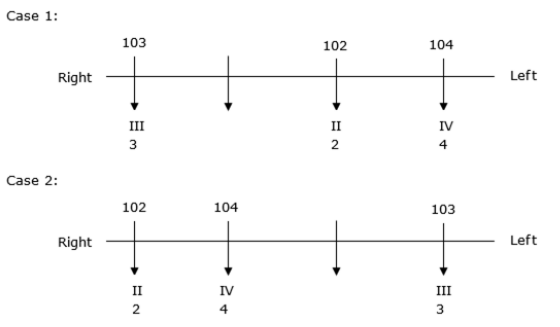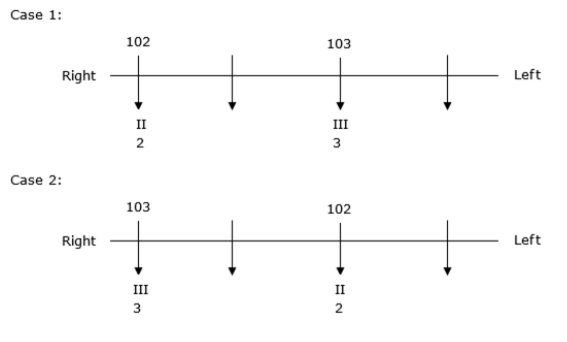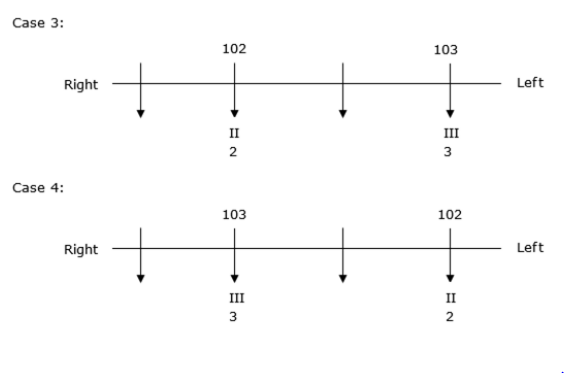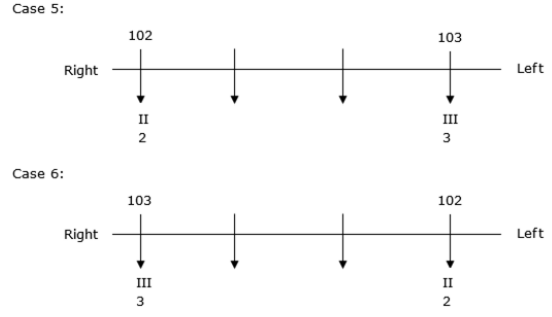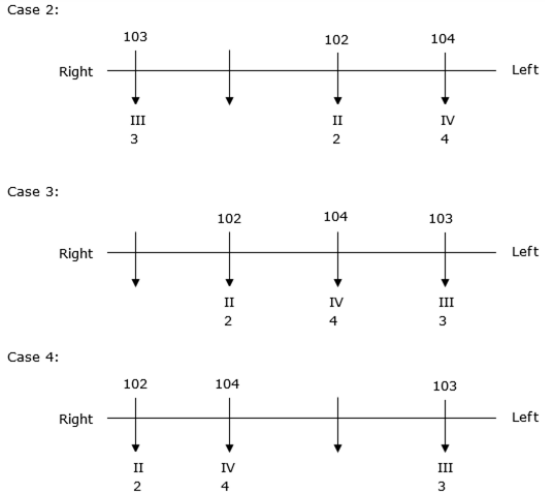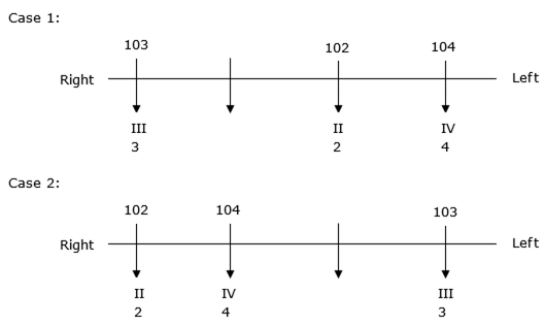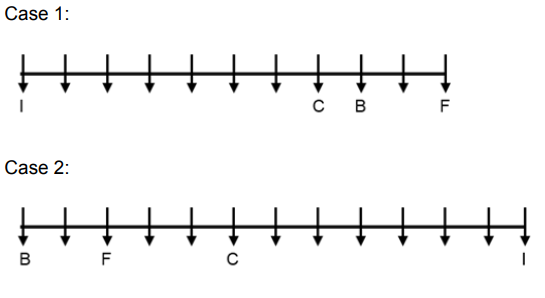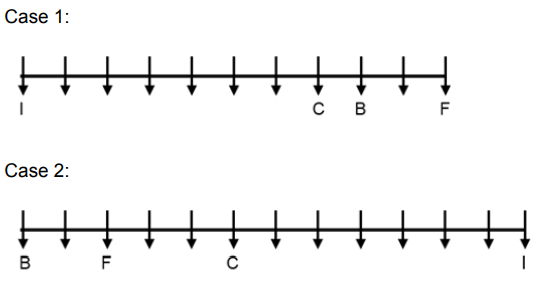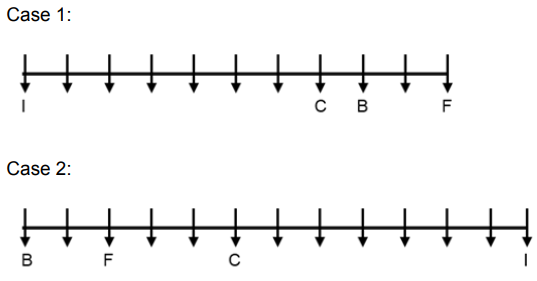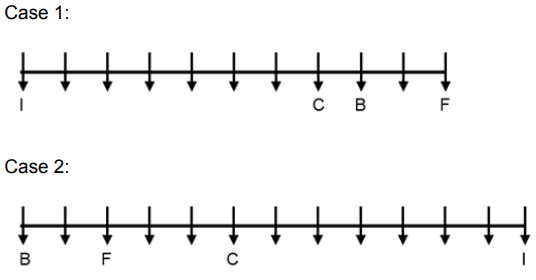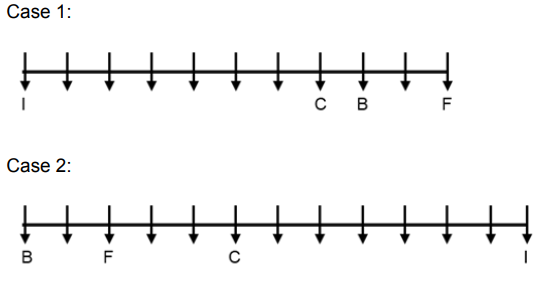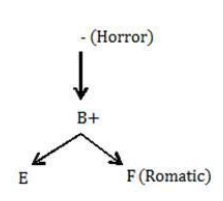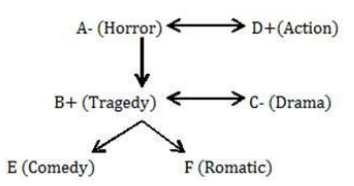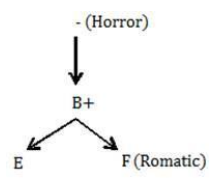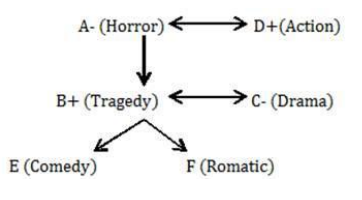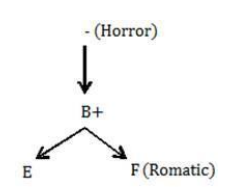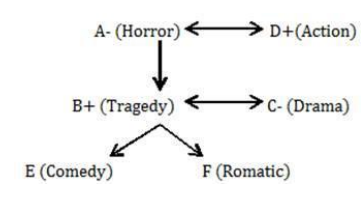
SBI PO Reasoning Questions and Answers PDF Download – Prelims, Mains: Hello! We have come up here to help you to excel in your preparation in the SBI PO Prelims and Mains Reasoning section. You can go through this page and can get to know the topics that will be covered in the SBI PO Reasoning Prelims, Mains Exam. However, along with the SBI PO Reasoning Questions, also we have provided the answers and explanations for them.
★★ SBI PO Prelims Mock Tests ★★
SBI PO Reasoning Questions and Answers
It is better to be fully prepared in Reasoning Questions for SBI PO before appearing for the SBI PO Exam. We suggest you not to miss anything from this page as everything here was furnished in a very precise way. Moreover, make use of the download link which we have provided after each section, to get the SBI PO Reasoning Questions and Answers PDF Download for Prelims, Mains. The link to download the SBI PO Reasoning Questions with Answers PDF can be found in the important links section.
SBI PO Reasoning Questions and Answers – Prelims
(1-5) Direction: Study the following data carefully and answer the questions accordingly.
Point N is 50m east of point M. Point K is 40m west of point J and 30m south of point L. Point G is 50m south of point F. Point D is 20m east of point C. Point M is 10m north of point L. Point H is 10m south of point J and 40m west of point G. Point E is 40m north of point D and 10m west of point F. Point B is 30m north of point C and 40m east of point A
1. Point B is in which direction of point H?
A. West
B. South
C. North-East
D. South-West
E. None of these
Answer: C
Explanation:
1) Point B is 30m north of point C and 40m east of point A.
2) Point D is 20m east of point C.
3) Point E is 40m north of point D and 10m west of point F.
4) Point G is 50m south of point F.
5) Point H is 10m south of point J and 40m west of point G.
6) Point K is 40m west of point J and 30m south of point L.
7) Point M is 10m north of point L.
8) Point N is 50m east of point M.
2. What is the shortest distance between points A and M?
A. 8√2m
B. 5√7m
C. 10√2m
D. 20√7m
E. Cannot be determined
Answer: C
Explanation:
1) Point B is 30m north of point C and 40m east of point A.
2) Point D is 20m east of point C.
3) Point E is 40m north of point D and 10m west of point F.
4) Point G is 50m south of point F.
5) Point H is 10m south of point J and 40m west of point G.
6) Point K is 40m west of point J and 30m south of point L.
7) Point M is 10m north of point L.
8) Point N is 50m east of point M.
Required distance = √(10)² + (10)² = √200 = 10√2m
Therefore, option C is the correct answer.
3. Point C is in which direction with respect to point N?
A. South
B. North-West
C. North-East
D. South-West
E. Cannot be determined
Answer: A
Explanation:
1) Point B is 30m north of point C and 40m east of point A.
2) Point D is 20m east of point C.
3) Point E is 40m north of point D and 10m west of point F.
4) Point G is 50m south of point F.
5) Point H is 10m south of point J and 40m west of point G.
6) Point K is 40m west of point J and 30m south of point L.
7) Point M is 10m north of point L.
8) Point N is 50m east of point M.
4. Find the odd one.
A. E, C
B. F, H
C. N, D
D. A, K
E. B, J
Answer: C
Explanation:
1) Point B is 30m north of point C and 40m east of point A.
2) Point D is 20m east of point C.
3) Point E is 40m north of point D and 10m west of point F.
4) Point G is 50m south of point F.
5) Point H is 10m south of point J and 40m west of point G.
6) Point K is 40m west of point J and 30m south of point L.
7) Point M is 10m north of point L.
8) Point N is 50m east of point M.
5. Point K is in which direction of point G?
A. West
B. South
C. North-east
D. North-West
E. None of these
Answer: D
Explanation:
1) Point B is 30m north of point C and 40m east of point A.
2) Point D is 20m east of point C.
3) Point E is 40m north of point D and 10m west of point F.
4) Point G is 50m south of point F.
5) Point H is 10m south of point J and 40m west of point G.
6) Point K is 40m west of point J and 30m south of point L.
7) Point M is 10m north of point L.
8) Point N is 50m east of point M.
6. Direction: In each of the questions below are given four statements followed by two conclusions. You have to take the given statements to be true even if they seem to be at variance from commonly known facts. Read both the conclusions and then decide which of the given conclusions logically follow from the given statements disregarding commonly known facts.
Statements:
Only a few triangles are circles.
No pentagons are circles.
All pentagons are triangles.
Few circles are squares.
Conclusions:
I. All squares being pentagon is a possibility.
II. Some triangles are definitely not squares.
A. If conclusion I follows
B. If conclusion II follows
C. Either conclusion I or conclusion II follows
D. Neither conclusion I nor conclusion II follows
E. Both the conclusions follow
Explanation:
The least possible Venn diagram for the given statements is as follows:
Conclusions:
- All squares being pentagon is a possibility à Some squares are circle and no circle is pentagon. It means some squares which are circle can never be pentagon. Hence, it’s not true.
- Some triangles are definitely not squares à There is no direct link between triangle and square. Hence it’s doubtful.
Therefore, neither I nor II follows.
(7-11) Direction: In the following questions, a statement or statements are given followed by some conclusions. Study the following data carefully and answer the questions accordingly.
A #B means A is smaller than B
A – B means A is either smaller than or equal to B
A @ B means A is greater than B
A * B means A is either greater than or equal to B
A ) B means A is equal to B
7. Statements:
H * M # E – D @ X
Conclusions:
I. X @ E
II. D @ M
A. If only conclusion I follow
B. If only conclusion II follows
C. If either conclusion I or II follows
D. If neither conclusion I nor II follows
F. If both conclusions I and II follows
Answer: B
Explanation: H ≥ M < E ≤ D > X
8. Statements:
Z ) M @ V ) K – R * H
Conclusions:
I. V @ R
II. Z ) R
A. If only conclusion I follow
B. If only conclusion II follows
C. If either conclusion I or II follows
D. If neither conclusion I nor II follows
E. If both conclusions I and II follow
Answer: D
Explanation: Z = M > V = K ≤ R ≥ H
9. Statements:
W ) O @ D, R * W
Conclusions:
I. R ) D
II. R @ D
A. If only conclusion I follow
B. If only conclusion II follows
C. If either conclusion I or II follows
D. If neither conclusion I nor II follows
E. If both conclusions I and II follow
Answer: B
Explanation: R ≥ W = O > D
10. Statements:
N * P ) Y, L – R * N
Conclusions:
I. L ) N
II. R ) P
A. If only conclusion I follow
B. If only conclusion II follows
C. If either conclusion I or II follows
D. If neither conclusion I nor II follows
E. If both conclusions I and II follows
Answer: D
Explanation: L ≤ R ≥ N ≥ P = Y
11. Statements:
J * I, F @ G, J ) G
Conclusions:
I. F @ J
II. I # F.
A. If only conclusion I follow
B. If only conclusion II follows
C. If either conclusion I or II follows
D. If neither conclusion I nor II follows
E. If both conclusions I and II follow
Answer: E
Explanation: F > G = J ≥ I
11. In the following questions, a statement or statements are given followed by some conclusions. Study the following data carefully and answer the questions accordingly.
Statements:
A ≥ E > F = S < Q = Z ≤ V > P, S ≥ X > O
Conclusions:
I. Z > O
II. A > S
A. If only conclusion I follows
B. If only conclusion II follows
C. If either conclusion I or II follows
D. If neither conclusion I nor II follows
E. If both conclusions I and II follows
Answer: E
Explanation:
Z = Q > S ≥ X > O
A ≥ E > F = S
12. In a vertical stack of boxes, box P is 5 positions below box Q, which is 15th from the top. If box R, which is 10th from the bottom, is 3 position above box P, how many boxes are there in the stack?
A. 25
B. 28
C. 26
D. 20
E. None of these
Answer: C
Explanation:
Q is 15th box from the top means there are 14 boxes above box Q.
P is 5 positions below box Q means there are 4 boxes between P and Q.
R is 3 positions above box P means there are 2 boxes between R and P.
R is 10th box from the bottom means there are 9 boxes below box R.
Total boxes = 14 + 1 + 1 + 1 + 2 + 1 + 6 = 26
(Q: 13-17). Study the following data carefully and answer the questions accordingly.
- In a certain code language-
- ‘rage about make’ is written as ‘na cc ff’,
- ‘rage class fast main size’ is written as ‘qq rr ts cc vp’,
- ‘roof about class fast blast’ is written as ‘vp ff ts ie jg’
- ‘stop class size’ is written as ‘tt vp rr’.
13. What is the code for ‘size’?
A. vp
B. cc
C. qq
D. rr
E. Can’t be determined
Answer: D
Explanation:
Class = vp
Size = rr
Stop = tt
Main = qq
Roof/Blast = ie/jg
Rage = cc
About = ff
Make = na
Fast = ts
14. What is the code for ‘stop fast class main’?
A. vp qq jg ie
B. qq tt ts rr
C. ts vp ff ie
D. tt ts vp qq
E. Can’t be determined
Answer: D
Explanation:
Class = vp
Size = rr
Stop = tt
Main = qq
Roof/Blast = ie/jg
Rage = cc
About = ff
Make = na
Fast = ts
15. Which of the following is coded as ‘jg’?
A. class
B. main
C. blast
D. roof
E. Can’t be determined
Answer: E
Explanation:
Class = vp
Size = rr
Stop = tt
Main = qq
Roof/Blast = ie/jg
Rage = cc
About = ff
Make = na
Fast = ts
16. What could be the code for ‘bring class make’?
A. yr vp ts
B. na vp tt
C. vp na sr
D. er tt ts
F. None of these
Answer: C
Explanation:
Class = vp
Size = rr
Stop = tt
Main = qq
Roof/Blast = ie/jg
Rage = cc
About = ff
Make = na
Fast = ts
17. Which of the following is coded as ‘vp qq rr’?
A. main size rage
B. about class make
C. size class about
D. main size class
E. Can’t be determined
Answer: D
Explanation:
Class = vp
Size = rr
Stop = tt
Main = qq
Roof/Blast = ie/jg
Rage = cc
About = ff
Make = na
Fast = ts
(Q: 18-22) Study the following data carefully and answer the questions accordingly.
716 278 374 543 467 116
18. If one is added to the middle digit in each of the given numbers and then all the digits in each number are arranged in ascending order within the number then which of the following will be the smallest number?
A. Can’t be determined
B. 278
C. 716
D. 467
E. 116
Answer: E
Explanation:
716 278 374 543 467 116
After adding one – 726 288 384 553 477 126
After arranging in ascending order – 267 288 348 355 477 126
Smallest number – 267 288 348 355 477 126
19. If one is subtracted from each of the given numbers and then the first and the last numbers are interchanged, then which of the following numbers will be the largest?
A. 116
B. 278
C. 467
D. 716
E. Can’t be determined
Answer: B
Explanation:
716 278 374 543 467 116
After subtracting one – 715 277 373 542 466 115
After interchange – 517 772 373 245 664 511
Largest number – 517 772 373 245 664 511
20. If the first two digits of each of the given numbers are interchanged then which of the following will be the second-lowest number?
A. 278
B. 543
C. 116
D. 716
E. None of these
Answer: D
Explanation:
716 278 374 543 467 116
After interchange – 176 728 734 453 647 116
Second lowest number – 176 728 734 453 647 116
21. If all the numbers are arranged in descending order from the left to the right then which of the following will be the second number from the right?
A. 374
B. 116
C. 543
D. 278
E. None of these
Answer: D
Explanation:
716 278 374 543 467 116
After arranging in descending order – 716 543 467 374 278 116
Second number from the right – 716 543 467 374 278 116
22. If the digits in each number are written in the reverse order within the number then which number will be the third-highest?
A. 116
B. 716
C. 278
D. 543
E. None of these
Answer: B
Explanation:
716 278 374 543 467 116
After reverse order – 617 872 473 345 764 611
Third highest number – 617 872 473 345 764 611
23. Choose the word which is different from the rest?
A. LNPT
B. TVXZ
C. DFHJ
D. MOQS
E. None of these
Answer: A
Explanation:
The first letter moves two steps forward to give the second letter which moves two steps forward to give the third letter which moves two steps forward to give the fourth letter.
A: L + 2 = N; N + 2 = P; P + 4 = T
B: T + 2 = V; V+ 2 = X; X + 2 = Z
C: D + 2 = F; F + 2 = H; H + 2 = J
D: M + 2 = O; O + 2 = Q; Q + 2 = S
24. What will come in place of the question mark (?) in the given expression, such that the expression E < P and L > E become definitely true?
L = A ≥ C ? E; L ≤ P
A. >
B. =
C. ≤ or <
D. ≥
E. None of these
Answer: A
Explanation:
Putting ‘>’ in the place of ‘?’ we get,
Statement: L = A ≥ C > E; L ≤ P
On combining: P ≥ L = A ≥ C > E
P > E → True
L > E → True
25. Find the correct statement.
A. C goes on Wednesday
B. B goes to Nepal
C. D does not go on Thursday
D. A goes to Austria
F. None is correct
Answer: B
Explanation:
1) D goes to Gabon on Thursday.
2) Only one person goes between B and D.
3) The one, who goes immediately before B, goes to Iran but not on Monday.
(Here, case 2 will be eliminated and we will continue with case 1)
4) Three people go between A and the one, who goes to Iran.
5) F goes to Croatia but not on Tuesday.
6) C goes before E.
7) Neither C nor B goes to Brazil.
8) The one, who goes to Nepal, goes after Tuesday.
Therefore, option B is the correct answer.
26. In a queue of persons, facing the north direction, Pinky is 18th from the left end and Kia is 18th from the right end. Tony, who is sixth to the right of Pinky, is ninth to the left of Kia in the queue. How many persons are there in the queue?
A. 52
B. 48
C. 50
D. 55
E. None of these
Answer: C
Explanation:
Clearly, according to the given conditions,
There are 17 persons to the left of Pinky, as well as to the right of Kia. Also, Tony lies between Pink and Kia such that there are 5 persons between Tony and Pinky and 8 persons between Tony and Kia.
So, total persons = 17 + 1 + 5 + 1 + 8 + 1 + 17 = 50
(Q: 27-28) Study the following data carefully and answer the questions accordingly.
Twelve people are sitting in two rows that are parallel to each other. In row 1- A, B, C, D, E, and F are sitting facing south. In row 2- P, Q, R, S, T, and U are sitting facing north. D and R are not opposite to each other. Three people sit between B and F, who sits to the right of C. C sits opposite to Q. Four persons sit between S and T. Two people sit between P and R, who is not an immediate neighbor of T. Two people sit between A and C. Q sits second to the right of S.
27. How many of them sit between F and D?
A. Can’t be determined
B. Two
C. Three
D. One
E. Four
Answer: B
Explanation:
1) Four persons sit between S and T.
2) Q sits second to the right of S.
3) C sits opposite to Q.
4) Two people sit between A and C.
5) Three people sit between B and F, who sits to the right of C.
6) Two people sit between P and R, who is not an immediate neighbor of T.
7) D and R are not opposite to each other.
28. Who sits opposite to D?
A. P
B. R
C. T
D. U
E. Can’t be determined
Answer: D
Explanation:
1) Four persons sit between S and T.
2) Q sits second to the right of S.
3) C sits opposite to Q.
4) Two people sit between A and C.
5) Three people sit between B and F, who sits to the right of C.
6) Two people sit between P and R, who is not an immediate neighbor of T.
7) D and R are not opposite to each other.
29. Who sits immediate right of S?
A. U
B. P
C. Q
D. R
E. None of these
Answer: D
Explanation:
1) Four persons sit between S and T.
2) Q sits second to the right of S.
3) C sits opposite to Q.
4) Two people sit between A and C.
5) Three people sit between B and F, who sits to the right of C.
6) Two people sit between P and R, who is not an immediate neighbor of T.
7) D and R are not opposite to each other.
30. Find the odd.
A. C
B. B
C. R
D. F
E. P
Answer: D
Explanation:
1) Four persons sit between S and T.
2) Q sits second to the right of S.
3) C sits opposite to Q.
4) Two people sit between A and C.
5) Three people sit between B and F, who sits to the right of C.
6) Two people sit between P and R, who is not an immediate neighbor of T.
7) D and R are not opposite to each other.
31. How many of them sit to the left of E?
A. Three
B. Five
C. Four
D. Two
F. None of these
Answer: C
Explanation:
1) Four persons sit between S and T.
2) Q sits second to the right of S.
3) C sits opposite to Q.
4) Two people sit between A and C.
5) Three people sit between B and F, who sits to the right of C.
6) Two people sit between P and R, who is not an immediate neighbor of T.
7) D and R are not opposite to each other.
32. How many such pairs of letters are there in the word Allotment each of which has as many letters between them in the word as in the English alphabet (Both forward and backward)?
A. Nil
B. One
C. Two
D. Three
E. None of these
Explanation:
There are 2 pairs.
(Q: 33-35) Direction: Study the following data carefully and answer the questions accordingly.
X is the mother-in-law of R. V is the son-in-law of G. T is the father of V. S is unmarried. W is the father of R and U is the brother-in-law of T. R is the sister-in-law of S, who is the niece of U.
33. How R is related to G?
A. Mother
B. Wife
C. Son
D. Daughter
E. None of these
Answer: D
Explanation:
34. Who is the father of S?
A. W
B. X
C. T
D. V
E. None of these
Answer: D
Explanation:
35. Find the odd one.
A. T
B. G
C. U
D. S
E. W
Answer: D
Explanation:
T, G, U, and W are of the same generation.
| SBI PO Reasoning Prelims Questions and Answers – Important Link | |
|---|---|
| To Download SBI PO Reasoning Questions and Answers PDF (Prelims) | Click Here |
SBI PO Reasoning Questions and Answers – Mains
(Q: 1-5) Direction: Study the following letter-number-symbol sequence and answer the questions following it.
S F E L 6 C O 3 N K I P 1 8 A B W 2 X 4 J 5 G Z 9 Q 7 V H
1. How many such digits are there in the above arrangement, each of which is immediately preceded by a consonant and immediately followed by a vowel?
A. Four
B. Three
C. Five
D. Two
E. None of these
Answer: E
Explanation:
S F E L 6 C O 3 N K I P 1 8 A B W 2 X 4 J 5 G Z 9 Q 7 V H
2. How many such consonants are there in the above arrangement, each of which is immediately preceded by a digit and immediately followed by a consonant?
A. None
B. Two
C. Three
D. Four
E. None of these
Answer: C
Explanation:
S F E L 6 C O 3 N K I P 1 8 A B W 2 X 4 J 5 G Z 9 Q 7 V H
3. Which of the following is sixth to the right of nineteenth from the right end of the above arrangement?
A. 6
B. B
C. W
D. 2
E. None of these
Explanation:
S F E L 6 C O 3 N K I P 1 8 A B W 2 X 4 J 5 G Z 9 Q 7 V H
19th element from the right end = I
6th element to the right of I = W
4. Four of the following five are alike in a certain way and form a group. Which is the one that does not belong to that group?
A. I1K
B. B2A
C. JX5
D. Z59
E. C3L
Answer: E
Explanation:
S F E L 6 C O 3 N K I P 1 8 A B W 2 X 4 J 5 G Z 9 Q 7 V H
5. Which of the following is eighth to the left of seventeenth from the left end of the given arrangement?
A. 9
B. K
C. N
D. 6
E. None of these
Explanation
S F E L 6 C O 3 N K I P 1 8 A B W 2 X 4 J 5 G Z 9 Q 7 V H
17th element from the left = W
8th element to the left of W = N
6. In the following questions assuming the given statement to be true, find which of the conclusion(s) among given conclusions is/are definitely true and then give your answers accordingly.
Statements:
X < L ≥ C = F ≤ Q > K ≤ Z; A > L < M
Conclusion:
I. M < Q
II. M > F
A. If only conclusion I follows
B. If only conclusion II follows
C. If either conclusion I or II follows
D. If neither conclusion I nor II follows
E. If both conclusions I and II follow
Answer: B
Explanation:
- M > L ≥ C = F ≤ Q —> False
- M > L ≥ C = F —> True
7. Which of the following symbols should replace the blanks in the given expression to make the expressions G < C and F ≥ H true?
B > C = D > N _ G > F = I _ H
A. ≤
B. ≥
C. =
D. >
E. Either ≥ or =
Answer: B
Explanation:
B > C = D > N ≥ G > F = I ≥ H
(Q: 8-9) Direction: Read the following information carefully to answer the questions based on it.
Seven people P, Q, R, S, T, U and V are going to give the examination in the same week starting from Monday in such a way that only one person gives the exam on a day, not necessarily in the same order. T’s exam is before U’s exam. Only one person’s exam is between R’s and V’s exam. S’ exam is just after P’s exam. U’s exam is after Q’s and S’ exam. R’s exam is just after S’ exam. Q’s exam is on Monday. Less than two persons’ exams are between P’s and T’s exam.
8. Who among the following person’s exam is on Saturday?
A. T
B. P
C. V
D. U
E. None of these
Answer: D
Explanation:
Persons: P, Q, R, S, T, U and V
Days order: Monday > Tuesday > Wednesday > Thursday > Friday > Saturday > Sunday
Steps:
1) Q’s exam is on Monday.
2) R’s exam is just after S’ exam.
3) S’ exam is just after P’s exam.
4) Only one person’s exam is between R’s and V’s exam.
CASE 1: Q > P > S > R > — > V > —
CASE 2: Q > — > P > S > R > — > V
5) Less than two persons’ exams are between P’s and T’s exam. It means Case 1 is ruled out.
6) T’s exam is before U’s exam.
CASE 2: Q > T > P > S > R > U > V
9. How many persons’ exams are after T’s exam?
A. 1
B. 0
C. 2
D. 5
E. None of these
Answer: D
Explanation:
Persons: P, Q, R, S, T, U and V
Days order: Monday > Tuesday > Wednesday > Thursday > Friday > Saturday > Sunday
Steps:
1) Q’s exam is on Monday.
2) R’s exam is just after S’ exam.
3) S’ exam is just after P’s exam.
4) Only one person’s exam is between R’s and V’s exam.
CASE 1: Q > P > S > R > — > V > —
CASE 2: Q > — > P > S > R > — > V
5) Less than two persons’ exams are between P’s and T’s exam. It means Case 1 is ruled out.
6) T’s exam is before U’s exam.
CASE 2: Q > T > P > S > R > U > V
10. Select the word which cannot be formed using the letters of the word MODERNISM.
A. DEMONISM
B. REMINDS
C. MODERNS
D. IMMERSION
E. MINORED
Answer: D
Explanation:
In the word MODERNISM, there is only one I while in the word IMMERSION, there are two I’s.
(Q: 11-13)) Direction: Study the following data carefully and answer the questions accordingly.
There are eight members in a family. J is the sister of Z. N and V are married to each other. V is the daughter of C . C is the grandmother of B, who is the nephew of X. N does not have any siblings. X is the parent of Z. D is the mother of Z.
11. How Z is related to V?
A. Nephew
Daughter
B. Son
C. Can’t be determined
D. None of these
Answer: D
Explanation:
12. Who is the daughter-in-law of C?
A. V
B. X
C. D
D. N
E. None of these
Answer: C
Explanation:
13. If Z is the sister of J then, how many males are in the family?
A. 1
B. 3
C. 2
D. 4
E. None of these
Answer: B
Explanation:
(Q: 14-18) Direction: Study the following data carefully and answer the questions accordingly.
Seven people A, B, C, D, E, F, and G are born on seven different days starting from Sunday of the same week but not necessarily in the same order. Each one of them belongs to different countries i.e. US, Sudan, Israel, Nepal, China, Japan, and Italy but not necessarily in the same order. Neither A nor D belongs to Sudan. B belongs to China and is born before G. Only three people are born between C and the one, who belongs to Italy. Only two people are born between D, who does not belong to Japan and E. F belongs to Israel. G is born just before A. The one, who belongs to Italy, is born on Monday. E belongs to Nepal and is born after Thursday.
14. Who belongs to US?
A. G
B. A
C. D
D. E
E. None of these
Answer: C
Explanation:
1) E belongs to Nepal and is born after Thursday.
2) Only two people are born between D, who does not belong to Japan and E.
3) The one, who belongs to Italy, is born on Monday.
4) Only three people are born between C and the one, who belongs to Italy.
(Here, case 1 will be eliminated and we will continue with the case 2)
5) G is born just before A.
6) B belongs to China and is born before G.
7) F belongs to Israel.
8) Neither A nor D belongs to Sudan.
(Refer point 2)
15. F is born on which of the following days?
A. Sunday
B. Tuesday
C. Thursday
D. Friday
E. None of these
Answer: C
Explanation:
1) E belongs to Nepal and is born after Thursday.
2) Only two people are born between D, who does not belong to Japan and E.
3) The one, who belongs to Italy, is born on Monday.
4) Only three people are born between C and the one, who belongs to Italy.
(Here, case 1 will be eliminated and we will continue with the case 2)
5) G is born just before A.
6) B belongs to China and is born before G.
7) F belongs to Israel.
8) Neither A nor D belongs to Sudan.
(Refer point 2)
16. How many of them are born after the one, who belongs to Japan?
A. Three
B. Four
C. Two
D. Five
E. None of these
Answer: B
Explanation:
1) E belongs to Nepal and is born after Thursday.
2) Only two people are born between D, who does not belong to Japan and E.
3) The one, who belongs to Italy, is born on Monday.
4) Only three people are born between C and the one, who belongs to Italy.
(Here, case 1 will be eliminated and we will continue with the case 2)
5) G is born just before A.
6) B belongs to China and is born before G.
7) F belongs to Israel.
8) Neither A nor D belongs to Sudan.
(Refer point 2)
17. G belongs to which of the following countries?
A. US
B. Italy
C. Sudan
D. Japan
E. None of these
Answer: B
Explanation:
1) E belongs to Nepal and is born after Thursday.
2) Only two people are born between D, who does not belong to Japan and E.
3) The one, who belongs to Italy, is born on Monday.
4) Only three people are born between C and the one, who belongs to Italy.
(Here, case 1 will be eliminated and we will continue with the case 2)
5) G is born just before A.
6) B belongs to China and is born before G.
7) F belongs to Israel.
8) Neither A nor D belongs to Sudan.
(Refer point 2)
18. Find the odd one.
A. B – Japan
B. C -US
C. F – Nepal
D. E – Sudan
E. G – US
Answer: D
Explanation:
1) E belongs to Nepal and is born after Thursday.
2) Only two people are born between D, who does not belong to Japan and E.
3) The one, who belongs to Italy, is born on Monday.
4) Only three people are born between C and the one, who belongs to Italy.
(Here, case 1 will be eliminated and we will continue with the case 2)
5) G is born just before A.
6) B belongs to China and is born before G.
7) F belongs to Israel.
8) Neither A nor D belongs to Sudan.
(Refer point 2)
As there is a gap of one element in all the given options, except option D.
(Q: 19-23) Direction: Study the following data carefully and answer the questions accordingly.
Eight persons A, B, C, D, E, F, G, and H are sitting in a straight line facing the north direction but not necessarily in the same order. D is sitting at an end. Three people are sitting between B and D. Two people are sitting between B and G. C sits second to the right of G. B is not an immediate neighbor of A. Two people are sitting between H and C. F is not an immediate neighbor of H. At least three people are sitting between D and G.
19. Who is sitting at the left end?
A. C
B. D
C. E
D. G
E. None of these
Answer: D
Explanation:
1) D is sitting at an end.
2) Three people are sitting between B and D.
3) Two people are sitting between B and G.
4) At least three people are sitting between D and G.
5) C sits second to the right of G.
(Here, case 1 will be eliminated and we will continue with the case 2)
6) Two people are sitting between H and C.
7) F is not an immediate neighbor of H.
8) B is not an immediate neighbor of A.
20. How many people are sitting to the right of E?
A. Two
B. Four
C. Three
D. One
E. None of these
Answer: C
Explanation:
1) D is sitting at an end.
2) Three people are sitting between B and D.
3) Two people are sitting between B and G.
4) At least three people are sitting between D and G.
5) C sits second to the right of G.
(Here, case 1 will be eliminated and we will continue with the case 2)
6) Two people are sitting between H and C.
7) F is not an immediate neighbor of H.
8) B is not an immediate neighbor of A.
21. Who is sitting third to the left of H?
A. D
B. E
C. C
D. G
E. None of these
Answer: C
Explanation:
1) D is sitting at an end.
2) Three people are sitting between B and D.
3) Two people are sitting between B and G.
4) At least three people are sitting between D and G.
5) C sits second to the right of G.
(Here, case 1 will be eliminated and we will continue with the case 2)
6) Two people are sitting between H and C.
7) F is not an immediate neighbor of H.
8) B is not an immediate neighbor of A.
22. Who are the immediate neighbors of F?
A. G, B
B. C, G
C. E, H
D. B, C
E. None of these
Answer: B
Explanation:
1) D is sitting at an end.
2) Three people are sitting between B and D.
3) Two people are sitting between B and G.
4) At least three people are sitting between D and G.
5) C sits second to the right of G.
(Here, case 1 will be eliminated and we will continue with the case 2)
6) Two people are sitting between H and C.
7) F is not an immediate neighbor of H.
8) B is not an immediate neighbor of A.
23. Find the odd one.
A. D, H
B. E, A
C. A, B
D. F, B
E. G, C
Answer: C
Explanation:
1) D is sitting at an end.
2) Three people are sitting between B and D.
3) Two people are sitting between B and G.
4) At least three people are sitting between D and G.
5) C sits second to the right of G.
(Here, case 1 will be eliminated and we will continue with the case 2)
6) Two people are sitting between H and C.
7) F is not an immediate neighbor of H.
8) B is not an immediate neighbor of A.
(Q: 24-25) Direction: Study the following data carefully and answer the questions accordingly.
Niru starts walking in the south direction and covered a distance of 12m. Now, he took two consecutive right turns and covered a distance of 10m and 15m respectively and reached point C. Now, he took left turn and covered a distance of 20m to reach point D.
24. Point D is in which direction of Niru’s starting point?
A. South
B. South-East
C. North-West
D. West
E. None of these
Answer: C
Explanation:
25. If Rajat is standing 3m north of Niru then what is the distance between Rajat and point C?
A. 15m
B. 12m
C. 10m
D. 8m
E. None of these
Answer: C
Explanation:
(Q: 26-30) Direction: Study the following data carefully and answer the questions accordingly.
In a certain code language-
‘health perfect race damage’ is written as ‘pc cj gc mq’,
‘damage version range total’ is written as ‘tc hc cw pc’,
‘health perfect facts damage’ is written as ‘gc cj sj pc’,
‘range total again’ is written as ‘hc cw vc’.
26. What could be the code for ‘perfect’?
A. pc
B. sj
C. gc
D. hc
E. vc
Answer: C
Explanation:
Total/Range = hc/cw
Again = vc
Damage = pc
Version = tc
Health/Perfect = gc/cj
Facts = sj
Race = mq
‘health perfect race damage’ is written as ‘pc cj gc mq’,
‘damage version range total’ is written as ‘tc hc cw pc’,
‘health perfect facts damage’ is written as ‘gc cj sj pc’,
‘range total again’ is written as ‘hc cw vc’.
27. Which of the following would be the code for ‘again health race’?
A. gc cj mq
B. cj mq vc
C. vc gc hc
D. vc mq gc
E. Can’t be determined
Answer: E
Explanation:
Total/Range = hc/cw
Again = vc
Damage = pc
Version = tc
Health/Perfect = gc/cj
Facts = sj
Race = mq
‘health perfect race damage’ is written as ‘pc cj gc mq’,
‘damage version range total’ is written as ‘tc hc cw pc’,
‘health perfect facts damage’ is written as ‘gc cj sj pc’,
‘range total again’ is written as ‘hc cw vc’.
28. Which of the following is coded as ‘hc’?
A. version
B. health
C. range
D. total
E. Can’t be determined
Answer: E
Explanation:
Total/Range = hc/cw
Again = vc
Damage = pc
Version = tc
Health/Perfect = gc/cj
Facts = sj
Race = mq
‘health perfect race damage’ is written as ‘pc cj gc mq’,
‘damage version range total’ is written as ‘tc hc cw pc’,
‘health perfect facts damage’ is written as ‘gc cj sj pc’,
‘range total again’ is written as ‘hc cw vc’.
29. What is the code for ‘race’?
A. pc
B. mq
C. gc
D. cj
E. None of these
Answer: B
Explanation:
Total/Range = hc/cw
Again = vc
Damage = pc
Version = tc
Health/Perfect = gc/cj
Facts = sj
Race = mq
‘health perfect race damage’ is written as ‘pc cj gc mq’,
‘damage version range total’ is written as ‘tc hc cw pc’,
‘health perfect facts damage’ is written as ‘gc cj sj pc’,
‘range total again’ is written as ‘hc cw vc’.
30. ‘total perfect health range’ can be coded as-
A. cj cw cw vc
B. gc hc sj vc
C. cw hc gc mq
D. gc cj cw hc
E. None of these
Answer: D
Explanation:
Total/Range = hc/cw
Again = vc
Damage = pc
Version = tc
Health/Perfect = gc/cj
Facts = sj
Race = mq
‘health perfect race damage’ is written as ‘pc cj gc mq’,
‘damage version range total’ is written as ‘tc hc cw pc’,
‘health perfect facts damage’ is written as ‘gc cj sj pc’,
‘range total again’ is written as ‘hc cw vc’.
31. How many such pairs of letters are there in the word ‘Judgment’ each of which has as many letters between them in the word as in the English alphabet (Both forward and backward)?
A. Nil
B. One
C. Two
D. Three
E. None of these
Answer: D
Explanation:
So, there are 3 pairs.
32. In a classroom of 32 students, the ratio of boys and girls is 7:9. Maria’s position is 12th among all the students from left and 8th among girls from the right. How many boys are sitting to the right of Maria?
A. 14
B. 8
C. 13
D. Cannot be determined
E. None of these
Answer: C
Explanation:
Number of girls = 32 x (9/16) = 18
Number of boys = 32 x (7/16) = 14
Maria’s position is 8th among girls from the right.
Among 18 girls, 7 girls are to the right of Maria.
So, the remaining girls are to the left of Maria i.e., (18 – 8) = 10
Number of boys to the left of Maria = 11 – 10 = 1
(Q: 33-37) Direction: Study the following information carefully and answer the questions given below:
First four Roman Numbers I, II, III, IV are synonymous to first four natural numbers 1, 2, 3, and 4 respectively. On a first floor of a building in south block, there are four flats having number 101, 102, 103, and 104 from left to right but not in same order. Four flats are assigned Roman Numbers in increasing order. Flat number 102 and 103 are not adjacent. IV is adjacent to II on left. Flat number 103 and 104 are not adjacent. There are two flats between 3 and 4.
33. Which Roman Number is assigned 1st from left?
A. I
B. II
C. III
D. IV
E. Cannot be determined
Answer: D
Explanation:
Four Flats: 101, 102, 103, 104
Four Roman Numbers: I, II, III, IV
Four flats are assigned Roman Numbers in increasing order and First four Roman Numbers I, II, III, IV are synonymous to first four natural numbers 1, 2, 3, and 4 respectively.
Flat number 101 – I – 1
Flat number 102 – II – 2
Flat number 103 – III – 3
Flat number 104 – IV – 4
Four flats having number 101, 102, 103, and 104 on first floor of south block are arranged from left to right.
Steps:
1) Flat number 102 and 103 are not adjacent.
Hence, six cases are possible.
IV is adjacent to II on left. Hence, Case 4 and 6 are eliminated.
3) Flat number 103 and 104 are not adjacent.
Hence, Case 1 and Case 3 are eliminated. We get two cases as seen below.
4) There are two flats between 3 and 4.
Hence, Case 2 is eliminated. We get the final arrangement by placing the remaining flat number 101 at the leftover position as given below.
34. Which flats are adjacent to each other?
A. 1,2
B. 2,3
C. 1,4
D. 3, 4
F. None of these
Answer: A
Explanation:
Four Flats: 101, 102, 103, 104
Four Roman Numbers: I, II, III, IV
Four flats are assigned Roman Numbers in increasing order and First four Roman Numbers I, II, III, IV are synonymous to first four natural numbers 1, 2, 3, and 4 respectively.
Flat number 101 – I – 1
Flat number 102 – II – 2
Flat number 103 – III – 3
Flat number 104 – IV – 4
Four flats having number 101, 102, 103, and 104 on first floor of south block are arranged from left to right.
Steps:
1) Flat number 102 and 103 are not adjacent.
Hence, six cases are possible.
IV is adjacent to II on left. Hence, Case 4 and 6 are eliminated.
3) Flat number 103 and 104 are not adjacent.
Hence, Case 1 and Case 3 are eliminated. We get two cases as seen below.
4) There are two flats between 3 and 4.
Hence, Case 2 is eliminated. We get the final arrangement by placing the remaining flat number 101 at the leftover position as given below.
Hence, 1,2 which stand for flat number 101 and 102 are adjacent to each other.
35. Which of the following arrangement of flat number from right to the left is correct?
A. II I II IV
B. IV I II III
C. III I II IV
D. I II III IV
E. IV II I III
Answer: C
Explanation:
Four Flats: 101, 102, 103, 104
Four Roman Numbers: I, II, III, IV
Four flats are assigned Roman Numbers in increasing order and First four Roman Numbers I, II, III, IV are synonymous to first four natural numbers 1, 2, 3, and 4 respectively.
Flat number 101 – I – 1
Flat number 102 – II – 2
Flat number 103 – III – 3
Flat number 104 – IV – 4
Four flats having number 101, 102, 103, and 104 on first floor of south block are arranged from left to right.
Steps:
1) Flat number 102 and 103 are not adjacent.
Hence, six cases are possible.
IV is adjacent to II on left. Hence, Case 4 and 6 are eliminated.
3) Flat number 103 and 104 are not adjacent.
Hence, Case 1 and Case 3 are eliminated. We get two cases as seen below.
4) There are two flats between 3 and 4.
Hence, Case 2 is eliminated. We get the final arrangement by placing the remaining flat number 101 at the leftover position as given below.
Hence, III I II IV is the correct arrangement of flat number.
36. Which flat is situated at extreme right?
A. 1
B. 2
C. 3
D. 4
E. Cannot be determined
Answer: C
Explanation:
Four Flats: 101, 102, 103, 104
Four Roman Numbers: I, II, III, IV
Four flats are assigned Roman Numbers in increasing order and First four Roman Numbers I, II, III, IV are synonymous to first four natural numbers 1, 2, 3, and 4 respectively.
Flat number 101 – I – 1
Flat number 102 – II – 2
Flat number 103 – III – 3
Flat number 104 – IV – 4
Four flats having number 101, 102, 103, and 104 on first floor of south block are arranged from left to right.
Steps:
1) Flat number 102 and 103 are not adjacent.
Hence, six cases are possible.
IV is adjacent to II on left. Hence, Case 4 and 6 are eliminated.
3) Flat number 103 and 104 are not adjacent.
Hence, Case 1 and Case 3 are eliminated. We get two cases as seen below.
4) There are two flats between 3 and 4.
Hence, Case 2 is eliminated. We get the final arrangement by placing the remaining flat number 101 at the leftover position as given below.
Hence, flat number 103 or III or 3 is situated at extreme right.
37. What is the position of flat number 102?
A. 1st from left
B. 2nd from left
C. 3rd from left
D. 4th from left
E. Cannot be determined
Answer: B
Explanation:
Four Flats: 101, 102, 103, 104
Four Roman Numbers: I, II, III, IV
Four flats are assigned Roman Numbers in increasing order and First four Roman Numbers I, II, III, IV are synonymous to first four natural numbers 1, 2, 3, and 4 respectively.
Flat number 101 – I – 1
Flat number 102 – II – 2
Flat number 103 – III – 3
Flat number 104 – IV – 4
Four flats having number 101, 102, 103, and 104 on first floor of south block are arranged from left to right.
Steps:
1) Flat number 102 and 103 are not adjacent.
Hence, six cases are possible.
IV is adjacent to II on left. Hence, Case 4 and 6 are eliminated.
3) Flat number 103 and 104 are not adjacent.
Hence, Case 1 and Case 3 are eliminated. We get two cases as seen below.
4) There are two flats between 3 and 4.
Hence, Case 2 is eliminated. We get the final arrangement by placing the remaining flat number 101 at the leftover position as given below.
Hence, flat number 102 is 2nd from left.
(Q: 38:42) Direction: Study the following information carefully and answer the following questions.
A certain number of persons are sitting in a linear row facing south. Only some people in the arrangement are known. Six persons sit between C and I. J sits third to the right of K. L sits fifth to the right of C. Not more than two persons sit between L and I. Only five persons sit to the right of M. J sits fifth to the left of F. Only three persons sit between J and P. Not less than nine persons sit between L and P. Not more than 20 persons can sit in the arrangement. B sits second to the right of F. Only two persons sit between F and C
38. How many persons are sitting in the given row?
A. 19
B. 20
C. 21
D. 18
E. Can’t be determined
Solution:
Direction: south
Steps:
1) B sits second to the right of F.
2) Only two persons sit between F and C.
3) Six persons sit between C and I.
4) L sits fifth to the right of C.
5) Not more than two persons sit between L and I.
The above conditions are not satisfied in case 2.
6) J sits third to the right of K.
7) J sits fifth to the left of F.
8) Only three persons sit between J and P.
9) Not less than nine persons sit between L and P.
10) Only five persons sit to the right of M.
The final arrangement will be as shown.
Hence, 20 persons are sitting in the given row.
39. How many persons sit between M and F?
A. Two
B. Four
C. Six
D. Eight
E. Can’t be determined
Solution:
Direction: south
Steps:
1) B sits second to the right of F.
2) Only two persons sit between F and C.
3) Six persons sit between C and I.
4) L sits fifth to the right of C.
5) Not more than two persons sit between L and I.
The above conditions are not satisfied in case 2.
6) J sits third to the right of K.
7) J sits fifth to the left of F.
8) Only three persons sit between J and P.
9) Not less than nine persons sit between L and P.
10) Only five persons sit to the right of M.
The final arrangement will be as shown.
Hence, four persons sit between M and F.
40. What is the position of J with respect to B?
A. 7th to the right
B. 6th to the right
C. 7th to the left
D. 6th to the left
E. Can’t be determined
Solution:
Direction: south
Steps:
1) B sits second to the right of F.
2) Only two persons sit between F and C.
3) Six persons sit between C and I.
4) L sits fifth to the right of C.
5) Not more than two persons sit between L and I.
The above conditions are not satisfied in case 2.
6) J sits third to the right of K.
7) J sits fifth to the left of F.
8) Only three persons sit between J and P.
9) Not less than nine persons sit between L and P.
10) Only five persons sit to the right of M.
The final arrangement will be as shown.
Hence, J sits seventh to the left of B.
41. Which of the following statements is true regarding the given arrangement?
A. More than seven persons sit between F and K.
B. Only three persons sit between M and B
C. K sits immediate left of P.
D. Only seven persons sit to the right of C.
E. None is true.
Solution:
Direction: south
Steps:
1) B sits second to the right of F.
2) Only two persons sit between F and C.
3) Six persons sit between C and I.
4) L sits fifth to the right of C.
5) Not more than two persons sit between L and I.
The above conditions are not satisfied in case 2.
6) J sits third to the right of K.
7) J sits fifth to the left of F.
8) Only three persons sit between J and P.
9) Not less than nine persons sit between L and P.
10) Only five persons sit to the right of M.
The final arrangement will be as shown.
Hence, “only seven persons sits to the right of C” is true.
42. How many persons sit between L and J?
A. 10
B. 11
C. 12
D. 14
E. Can’t be determined
Solution:
Direction: south
Steps:
1) B sits second to the right of F.
2) Only two persons sit between F and C.
3) Six persons sit between C and I.
4) L sits fifth to the right of C.
5) Not more than two persons sit between L and I.
The above conditions are not satisfied in case 2.
6) J sits third to the right of K.
7) J sits fifth to the left of F.
8) Only three persons sit between J and P.
9) Not less than nine persons sit between L and P.
10) Only five persons sit to the right of M.
The final arrangement will be as shown.
Hence, twelve persons sit between L and J.
(Q: 43-45) Direction: Read the following information carefully to answer the questions given below:
There are six people A, B, C, D, E and F in a family. Each one of them likes a different movie-style viz. Action, Drama, Romantic, Tragedy, Horror and Comedy, not necessarily in the same order. The one who likes horror movie is the grandmother of F who likes romantic movies. D, who likes action movie, is married to A. C, who likes drama movie, is married to the one who likes tragedy movie. B is the father of E and F. There are two married couples in the family.
43. Which of the following movies does E like?
A. Horror
B. Comedy
C. Action
D. Tragedy
E. None of these
Solution:
Persons: A, B, C, D, E, F
Movies: Action, Drama, Romantic, Tragedy, Horror and Comedy
Steps:
1) The one who likes horror movies is the grandmother of F who likes romantic movies.
2) B is the father of E and F.
3) D, who likes action movies, is married to A.
4) C, who likes drama movies, is married to the one who likes tragedy movies.
5) There are two married couples in the family.
The family tree is shown in the figure:
Clearly, E likes comedy movies.
44. How is A related to C?
A. Sister
B. Aunt
C. Grandmother
D. Mother
E. Mother-in-law
Solution:
Persons: A, B, C, D, E, F
Movies: Action, Drama, Romantic, Tragedy, Horror and Comedy
Steps:
1) The one who likes horror movies is the grandmother of F who likes romantic movies.
2) B is the father of E and F.
3) D, who likes action movies, is married to A.
4) C, who likes drama movies, is married to the one who likes tragedy movies.
5) There are two married couples in the family.
The family tree is shown in the figure:
Clearly, A is mother-on-law of C.
45. How many female members are there in the family?
A. One
B. Two
C. Three
D. Four
E. Cannot be determined
Solution:
Persons: A, B, C, D, E, F
Movies: Action, Drama, Romantic, Tragedy, Horror and Comedy
Steps:
1) The one who likes horror movies is the grandmother of F who likes romantic movies.
2) B is the father of E and F.
3) D, who likes action movies, is married to A.
4) C, who likes drama movies, is married to the one who likes tragedy movies.
5) There are two married couples in the family.
The family tree is shown in the figure:
Clearly, the gender of E and F are not clear.
| SBI PO Reasoning Questions and Answers – Important Link | |
|---|---|
| To Download SBI PO Mains Reasoning Questions and Answers PDF | Click Here |
Hoping that this article has helped you in a way to know regarding the SBI PO Reasoning Questions and Answers for Prelims and Mains. In order to get more latest updates from our page, follow us @ freshersnow.com.





